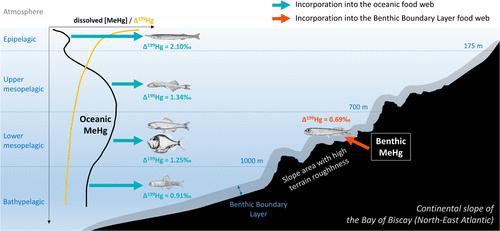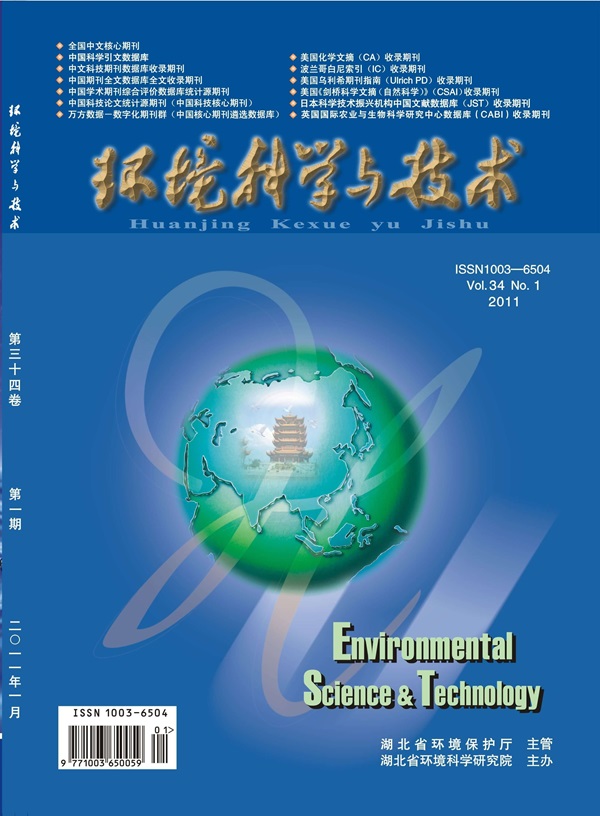汞稳定同位素揭示了东北大西洋大陆坡深海生物的垂直分布和营养生态学特征
IF 10.8
1区 环境科学与生态学
Q1 ENGINEERING, ENVIRONMENTAL
引用次数: 0
摘要
深海物种是海洋生态系统的核心,越来越容易受到全球变化和人类开发的影响。迄今为止,我们对这些群落的了解仍然有限,主要原因是观测困难,因此需要补充创新工具来更好地描述其生态特征。我们利用汞(Δ199Hg、δ202Hg、Δ201Hg 和 Δ200Hg)、碳(δ13C)和氮(δ15N)稳定同位素组成,根据其觅食深度和营养生态学将在比斯开湾(东北大西洋)大陆坡捕获的深海物种分开。鱼类 Δ199Hg 值随相应深度估计值(从海面到 1800 米)的下降证实,汞同位素能够根据觅食深度在很大的垂直梯度上分隔深海物种。同位素组成的结果还确定了不同的汞来源,这可能反映了大陆坡上不同的营养组合,特别是与纯海洋物种相比,某些物种受到底栖生物的影响。总之,我们的研究结果表明,汞稳定同位素可以为鲜为人知的深海觅食物种和群落的垂直觅食栖息地提供信息。本文章由计算机程序翻译,如有差异,请以英文原文为准。

Mercury Stable Isotopes Reveal the Vertical Distribution and Trophic Ecology of Deep-Pelagic Organisms over the North-East Atlantic Ocean Continental Slope
Deep-pelagic species are central to marine ecosystems and increasingly vulnerable to global change and human exploitation. To date, our understanding of these communities remains limited mainly due to the difficulty of observations, calling for complementary innovative tools to better characterize their ecology. We used mercury (Δ199Hg, δ202Hg, Δ201Hg, and Δ200Hg), carbon (δ13C), and nitrogen (δ15N) stable isotope compositions to segregate deep-pelagic species caught on the continental slope of the Bay of Biscay (NE Atlantic) according to their foraging depth and trophic ecology. Decreasing fish Δ199Hg values with corresponding depth estimates from the surface to down to 1,800 m confirmed that mercury isotopes are able to segregate deep species over a large vertical gradient according to their foraging depth. Results from isotopic compositions also identified different mercury sources, likely reflecting different trophic assemblages over the continental slope, in particular, the demersal influence for some species, compared to purely oceanic species. Overall, our results demonstrate how mercury stable isotopes can inform the vertical foraging habitat of little-known species and communities feeding in the deep.
求助全文
通过发布文献求助,成功后即可免费获取论文全文。
去求助
来源期刊

环境科学与技术
环境科学-工程:环境
CiteScore
17.50
自引率
9.60%
发文量
12359
审稿时长
2.8 months
期刊介绍:
Environmental Science & Technology (ES&T) is a co-sponsored academic and technical magazine by the Hubei Provincial Environmental Protection Bureau and the Hubei Provincial Academy of Environmental Sciences.
Environmental Science & Technology (ES&T) holds the status of Chinese core journals, scientific papers source journals of China, Chinese Science Citation Database source journals, and Chinese Academic Journal Comprehensive Evaluation Database source journals. This publication focuses on the academic field of environmental protection, featuring articles related to environmental protection and technical advancements.
 求助内容:
求助内容: 应助结果提醒方式:
应助结果提醒方式:


